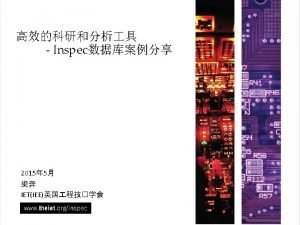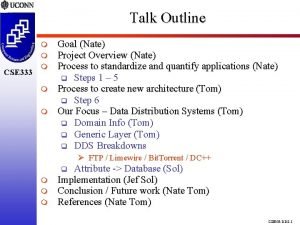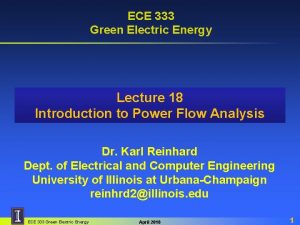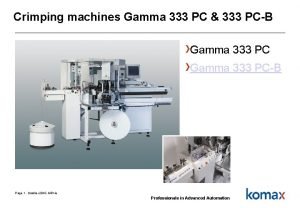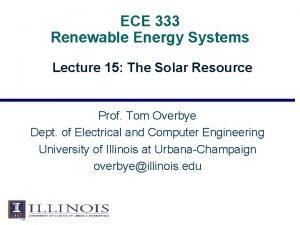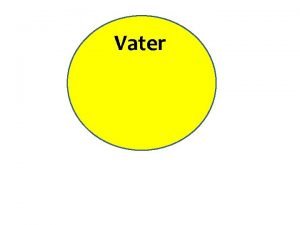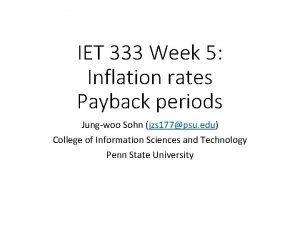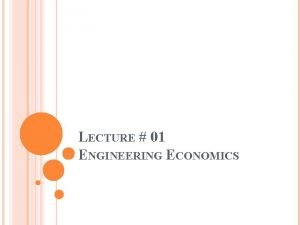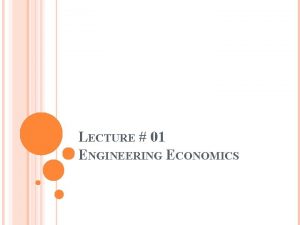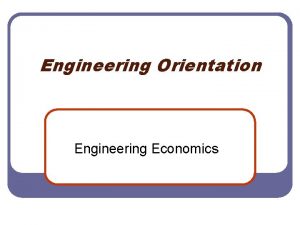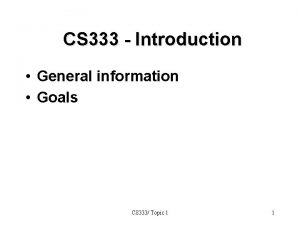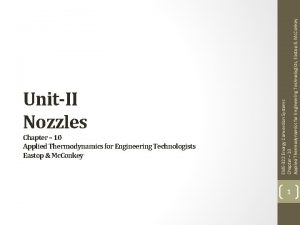IET 333 Engineering Economics for Technologists Jungwoo Sohn




















- Slides: 20

IET 333: Engineering Economics for Technologists Jung-woo Sohn (jwsohn@ist. psu. edu) College of Information Sciences and Technology Penn State University

About me: • Jung-woo Sohn • Contact information: • E-mail: jzs 177@psu. edu • Office: TBD in LRC • Office hour: TBD on Tuesday or Thursday • Teaching career: • Instructor: • Introduction to programming in C++ (CMPSC 121, Spring 2014) • Teaching assistant: College of Info Sci & Tech at UP • Many courses largely programming, business, economics, or engineering disciplines

My background • Pretty much interdisciplinary: • • B. S. , M. S. in Aerospace Engineering M. S. in Information Science M. S. in Economics Ph. D. in Information Sciences and Technology • Computer science (artificial intelligence) • Experimental economics • Others • Linux geek • Likes computer games but haven’t played for a long time • Not good at recognizing faces • Feel free to approach me!

Your introduction? • Name? • Majors? • Years in college? • Any comments?

Syllabus

Course overview • Engineering Economics: • Projects: • Technically workable • Financially makes sense • Financial factor: • Engineers need to understand minimum for communication • Example: • production of a ball point pen • Imagine you are an engineer capable of producing a ball point pen • What will you do?

Ball point pen production example: proposal • Pure engineering approach: • Mechanical engineers • Ball tip point • Milling machine • Material science & engineers • Plastic • Metal • Ink • Technically, you can produce it • But how much will it cost? • $1, 000? $10, 000?

Ball point pen production example: proposal • Now comes in the business people • Lens 1: Cost reduction • Production in factory: • Economy of scale • Plan proposal: Mass production • Build a large factory • Employ workers • Purchase machines: • For milling ball tips, plastic barrel, etc. • And produce a lot: • say 1000 pens per day • Sell them to market: 10 cents per pen

Ball point pen production example: proposal • Lens 2: Investment • But how do we collect the money for the start? • What if this production can make more money? • Incentive for investors! • Then how would you convince your investors? • Prediction for profit • Risk management (beyond our scope!) • Wait, can you be more precise? • • • Of course profit! Growth rate Interest rate Value in the future Etc.

Modern market economy • Proposals, proposals! • Mostly in written forms • You need to show some numbers • Proposal presentations: • Gaming industry: • 15 minutes of pitch presentation • Academic conference: • 20 minutes of paper presentation • Government funding: • 20 -60 minutes of proposal presentations • They are all about: does it make sense? • Making payoffs • Minimizing cost

Your role in this market landscape • Engineers: • No need to become a primary role in this proposal making • But need to understand how market works • And the incentive of the investors • Communication between business people • In a broader sense: • Understand how market works • Understand what are the demands out there • Microeconomics: • Theories for economic decision-making behaviors

Your role in this market place • Wait, no primary role for engineers/scientists? • New market landscape • Smartphone example • Pure engineering: technically feasible • Programs ready, hardware ready, production easy • Wireless internet ready • Pure business: • Cell phones sell well • Sales of cell phones with internet access, additional features, etc. • Concept of software platform • Steve Jobs and Apple: they understand both • Technology: Identified the need for mobile software platform • Business: Created a new smartphone market • Large user-base of Apple consumers • Contract with AT&T

Back to engineering economics • Big topics: • Making payoffs: profit maximization/cost minimization • Risk management • Understand market systems • For this course, we focus on: • In particular: • Interest rates • Value appreciation/depreciation

Test your current knowledge: A kingdom and a hero • As a hero, you saved a kingdom. The king promised to reward back to you with land. He gives you two choices and you need to pick one. Which one will you choose? 1. 10, 000 square miles of land per month • 10000, … 2. 0. 01 square miles for the first month, but doubles up every month • 0. 01, 0. 02, 0. 04, 0. 08, … 10, 000 sq miles vs. 0. 01 sq miles

Exponential growth: • What do you think? • Any real-world example? • Credit card • Car loans • Economic growth • National level • Organizational level • Chip design • Moore’s law

Making comparison: • Compare to what? How? • Amount vs. Ratio • Growth of: 1 inch? 2%? Past year Now

Simple interest •

Compounding interest • Interest earns interest • Interest is added to the principal for the next period • Example: • $1000 Principal, annual interest rate 10%, 3 -yr loan • First year: $1000 * 10% = $100 • New principal at the end of the year: $1000 + $100 = $1100 • Second year: $1100 * 10% = $110 • New principal: $1100 + $110 = $1210 • Third year: $1210 * 10% = $121 • Total interest: $331

Arithmetic series: •

Geometric series: •
 Jungwoo mechanical engineering
Jungwoo mechanical engineering Template jungwoo
Template jungwoo Iet600 download
Iet600 download Iet electronics letters
Iet electronics letters Venipuncture radiologic technologist
Venipuncture radiologic technologist Dein tod hat uns befreit
Dein tod hat uns befreit Vater-sohn wochenende ideen
Vater-sohn wochenende ideen Wenn die vorhaut zuhaut
Wenn die vorhaut zuhaut Der barmherzige samariter comic
Der barmherzige samariter comic Geburtstag von romy schneider
Geburtstag von romy schneider Gunho sohn
Gunho sohn Comos sohn
Comos sohn Economics and business economics maastricht
Economics and business economics maastricht Non mathematical economics
Non mathematical economics Binary domain torrent
Binary domain torrent Ece333
Ece333 Komax gamma 333 pc manual
Komax gamma 333 pc manual Ofc <333
Ofc <333 Sbr 333 kragujevac
Sbr 333 kragujevac Uiuc ece 333
Uiuc ece 333 Cse333 hw3
Cse333 hw3



